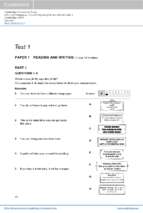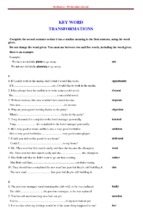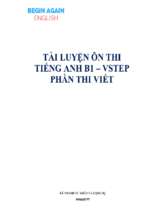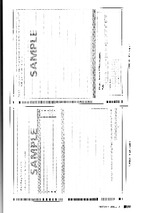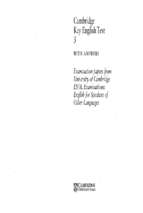VIETNAM NATIONAL UNIVESITY, HANOI
VIETNAM JAPAN UNIVERSITY
TRAN QUYNH GIAO
A COMPARATIVE STUDY ON
THE HORIZONTAL
COEFFICIENT OF
CONSOLIDATION (Cr) OBTAINED
FROM LAB TESTS
MASTER’S THESIS
Hanoi, 2020
VIETNAM NATIONAL UNIVESITY, HANOI
VIETNAM JAPAN UNIVERSITY
TRAN QUYNH GIAO
A COMPARATIVE STUDY ON
THE HORIZONTAL
COEFFICIENT OF
CONSOLIDATION (Cr) OBTAINED
FROM LAB TESTS
MASTER’S THESIS
MAJOR: INFRASTRUCTURE ENGINEERING
CODE: 8900201.04 QTD
RESEARCH SUPERVISOR:
Dr. NGUYEN TIEN DUNG
Hanoi, 2020
ABSTRACT
When a soft ground is improved by PVDs, consolidation takes place under the
condition of drainage in both horizontal and vertical directions. Naturally,
horizontal coefficient of consolidation (cr) is larger than the vertical coefficient of
consolidation (cv) by a factor of 3 to 5. The cv value is commonly interpreted from
consolidation test using incremental loading method [1]. However, up to date, there
have not been any similar standards for the consolidation test with horizontal
drainage (using incremental loading method).
The key goals of the research are: (1) determine the most reliable methods among
the proposed methods for determining the horizontal coefficient of consolidation
(cr) in the literature; (2) determine correlations between cr values obtained from
central drain (CD) test and peripheral drain (PD) test; (3) determine correlations
between vertical coefficients of consolidation (cv) and radial cr for a number of test
sites in Vietnam.
A desk study is carried out to secure the following: (1) a literature review on
equipment used for the test and existing methods used to evaluate the cr value; (2)
the thesis using data collected from the following sources literature review and test
site in Vietnam.
Overall, The most reliable methods for determining the horizontal coefficient of
consolidation (cr) is non-graphical method and the root t can be used to determine
the radial (horizontal) coefficient of consolidation (cr).
cr,PD is less than the cr,CD by a factor of 0.32 to 0.64 from intact samples and 0.33 to
0.58 from remolded samples.
cr PD is larger than the cv by a factor of 0.90 to 2.33, cr CD is larger than the cv by a
factor of 2.14 to 5.12 from intact samples. cr PD is less than the cv by a factor of 0.35
to 1.01, cr CD is less than the cv by a factor of 0.41 to 0.82 from intact samples.
i
ACKNOWLEDGEMENTS
I would like to express my sincere appreciation for the lecturers of Master of
Infrastructure Engineering Program for their help during my undergraduate at
Vietnam Japan University (VJU).
My thesis supervisor Dr. Nguyen Tine Dung for his enthusiasm, patience, advice
and continuous source of ideas for me. Dr. Dung is always ready to answer my
questions. His support in professional matters is invaluable.
I would like to acknowledge the sincere inspiration from Prof. Nguyen Dinh Duc
and Prof. Hironori Kato. Their lectures covered not only specialist knowledge but
also the responsibility and mission of a new generation of Vietnam. I am grateful to
Dr. Phan Le Binh for his support in the last two years since I have studied at
Vietnam Japan University. Thanks to him, I have learned the professional courtesy
of Japanese people as well as Japanese culture.
Finally, I want to spend thank to my parents and friends for their unflinching
support in the tough time. Their support, spoken or unspoken, has helped me
complete my master thesis.
ii
TABLE OF CONTENTS
Page
ABSTRACT ................................................................................................................ i
ACKNOWLEDGEMENTS ....................................................................................... ii
TABLE OF CONTENTS .......................................................................................... iii
LIST OF TABLES .................................................................................................... vi
LIST OF FIGURES................................................................................................... vi
LIST OF ABBREVIATIONS ................................................................................. viii
CHAPTER 1. INTRODUCTION ...............................................................................1
1.1 Problem statement .............................................................................................1
1.2 Necessity of study .............................................................................................3
1.3 Objectives ..........................................................................................................4
1.4 Scope of study ...................................................................................................4
1.5 Structure of thesis ..............................................................................................4
CHAPTER 2. LITERATURE REVIEW ....................................................................6
2.1 Introduction .......................................................................................................6
2.1.1 Consolidation Theory with Horizontal Drainage .......................................8
2.1.2 Solution of the governing equation (2.2) for a central drain (CD) under
equal strain loading (ESL) condition ..................................................................8
2.1.3 Solution of the governing equation (2.2) for a peripheral drain (PD)
under free strain loading (FSL) condition ...........................................................9
2.1.4 Solution of the governing equation (2.2) for a peripheral drain (PD)
under equal strain loading (ESL) condition ........................................................9
2.2 Existing methods for determining cr from consolidation test with a peripheral
drain using incremental loading ............................................................................10
2.2.1 Root t method [6] .....................................................................................10
2.2.2 Inflection point method [9] ......................................................................11
2.2.3 Full – match method [10] .........................................................................13
2.3 Existing methods for determining cr from consolidation test with a central
drain using incremental loading method ...............................................................15
2.3.1 Root t method [11] ...................................................................................15
2.3.2 Matching log (de2/t) and Ur method [12] ..................................................16
2.3.3 Inflection point method [13] ....................................................................17
2.3.4 Non-graphical method [14] ......................................................................18
2.3.5 Log - log method [15] ..............................................................................19
2.3.6 Steepest tangent fitting method [16] ........................................................20
2.3.7 Log t method [17].....................................................................................22
2.3.8 Full – match method [10] .........................................................................24
2.4 Summary of methods for determining cr.........................................................25
2.5 Linear regression analysis ...............................................................................25
2.6 Log normal distribution method .....................................................................26
CHAPTER 3. METHODOLOGY ............................................................................27
iii
3.1 Introduction .....................................................................................................27
3.2 Data collection ................................................................................................28
3.3 Improvement for inflection point methods .....................................................28
3.3.1 Theoretical development ..........................................................................28
3.3.2 The procedure for this method .................................................................29
3.4 Analysis of Time – Compression curve ..........................................................29
3.5 Procedure to select the best methods ..............................................................30
3.6 Procedure to determine ratios of cr PD /cr CD or cr /cv .......................................31
CHAPTER 4. TEST RESULTS & DISCUSSIONS .................................................33
4.1 Introduction .....................................................................................................33
4.2 Summary of database ......................................................................................33
4.2.1 Data collected from the literature.............................................................33
4.2.2 Data collected from test sites in Vietnam ................................................34
4.2.3 Summary of test data ................................................................................37
4.3 Evaluation and selection the best methods on intact samples .........................38
4.3.1 Graph results on intact samples ...............................................................38
4.3.2 Summary of results on intact samples......................................................40
4.3.3 Summary of rank method on intact samples ............................................47
4.4 Evaluation and selection the best methods on literature data .........................49
4.4.1 Graph results on literature data ................................................................49
4.4.2 Summary of results on literature data ......................................................51
4.4.3 Summary of rank method on literature data.............................................52
4.5 Evaluation and selection the best methods on remolded samples ..................54
4.5.1 Graph results on remolded samples .........................................................54
4.5.2 Summary of results on remolded samples ...............................................56
4.5.3 Summary of rank method on remolded samples ......................................62
4.6 Comparison of cr CD and cr PD on intact samples ..............................................64
4.6.1 Graph results on intact samples ...............................................................64
4.6.2 Summary of results on intact samples......................................................64
4.7 Comparison of cr CD and cr PD on remolded samples ........................................66
4.7.1 Graph results on remolded samples .........................................................66
4.7.2 Summary of results from remolded samples............................................66
4.8 Comparison of cv and cr PD on intact samples..................................................68
4.8.1 Graph results on intact samples ...............................................................68
4.8.2 Summary of results on intact samples......................................................68
4.9 Comparison of cv and cr CD on intact samples .................................................70
4.9.1 Graph results on intact samples ...............................................................70
4.9.2 Summary of results on intact samples......................................................70
4.10 Comparison of cv and cr PD on remolded samples .........................................72
4.10.1 Graph of results on remolded samples ...................................................72
4.10.2 Summary of results on remolded samples .............................................72
4.11 Comparison of cv and cr CD on remolded samples .........................................74
4.11.1 Graph results on remolded samples .......................................................74
4.11.2 Summary of results on remolded samples .............................................74
iv
CHAPTER 5. CONCLUSIONS & RECOMMENDATIONS ..................................76
REFERENCES ..........................................................................................................79
v
LIST OF TABLES
Page
Table 2.1. Boundary condition ....................................................................................9
Table 2.2. Existing methods for determining cr from radial consolidation ..............25
Table 4.1. Summary of data from literature for the PD – ESL condition .................33
Table 4.2. Summary of data from literature for the CD – ESL condition ................34
Table 4.3. Summary of tests done on intact samples ................................................37
Table 4.4. Summary of tests done on remolded samples ..........................................37
Table 4.5. Summary of results from PD tests on intact samples ..............................40
Table 4.6. Summary of results from CD tests on intact samples ..............................42
Table 4.7. Rank of each criterion with each pressure from PD tests on intact
samples...............................................................................................................44
Table 4.8. Rank of each criterion with each pressure for CD case on intact samples
...........................................................................................................................45
Table 4.9. Summary of rank for each method from PD tests on intact samples .......47
Table 4.10. Summary of rank on each meth1od from CD tests on intact samples ...48
Table 4.11. Summary of results from PD tests on literature for 8 methods. ............51
Table 4.12. Summary of results from CD tests on literature for 8 methods. ............52
Table 4.13. Summary of rank on each method from PD tests on literature ..............52
Table 4.14. Summary of rank on each method from CD tests on literature .............53
Table 4.15. Summary results from PD tests on remolded samples for 8 methods ...56
Table 4.16. Summary of results from CD tests on remolded samples for 8 methods
...........................................................................................................................58
Table 4.17. Rank of each criterion with each pressure from PD tests on remolded
samples for 8 methods .......................................................................................59
Table 4.18. Rank of each criterion with each pressure from CD tests on remolded
samples for 8 methods .......................................................................................61
Table 4.19. Summary of rank each method from PD tests on remolded samples ....62
Table 4.20. Summary of rank each method from CD tests on remolded samples ....63
Table 4.21. Summary of results from PD and CD tests on intact samples ...............65
Table 4.22. Summary of boundary for PD and CD case on intact samples ..............65
Table 4.23. Summary of correlations for CD and PD case on remolded samples ....67
Table 4.24. Summary of boundary for CD and PD case on remolded samples .......67
Table 4.25. Summary of correlations for PD case on intact samples .......................69
Table 4.26. Summary of boundary for PD case on intact samples ...........................69
Table 4.27. Summary of correlation for CD case on intact samples ........................71
Table 4.28. Summary of boundary for CD method on intact samples .....................71
vi
Table 4.29. Summary of correlations for PD case on remolded samples .................73
Table 4.30. Summary of boundary for PD case on remolded samples .....................73
Table 4.31. Summary of correlations for CD method on remolded samples ...........75
Table 4.32. Summary of boundary for CD method on remolded samples ...............75
vii
LIST OF FIGURES
Page
Figure 1.1. Map of distribution of major soil types in Indochinese ............................1
Figure 1.2. Soil phase diagram [3] ..............................................................................2
Figure 1.3. An Illustration of soft ground improved by PVDs ...................................2
Figure 2.1. Research direction of the thesis [5] ..........................................................7
Figure 2.2. Illustration of flow conditions for equal-strain case [6] ...........................7
Figure 2.3. Time - deformation plot during consolidation for a given load increment
[3] ................................................................................................................................8
Figure 2.4. Consolidation curve relating square - Root time factor to for drainage
radially outwards to periphery with equal strain loading [6]. ...................................11
Figure 2.5. Log (Ur/Tr) - log Ur relationship [10] .....................................................13
Figure 2.6. Determine the value of intersection point in full – match method .........14
Figure 2.7. Theoretical log(de2/t) versus Ur curves [12] ...........................................16
Figure 2.8. (a) Theretical Ur - log Tr curve and (b) d(Ur)/dlog Tr plot [13] ..............17
Figure 2.9. Log( - 0) versus log t plot [15] ............................................................20
Figure 2.10. Steepest tangent fitting method for determination of cr .......................21
Figure 3.1. Flow chart of the study ...............................................................................
Figure 3.2. Experimental data [9] .............................................................................28
Figure 3.3. Flowchart of identifying the best methods ............................................30
Figure 3.4. Flowchart of identifying the best methods .............................................31
Figure 4.1. Locations of test sites in Viet Nam (VSIP site, DVIZ site, Kim Chung
site) ............................................................................................................................34
Figure 4.2. Test location at Kim Chung site .............................................................35
Figure 4.3. Test location at VSIP site .......................................................................35
Figure 4.4. Test location at DVIZ site ......................................................................35
Figure 4.5. Soil profile at DVIZ ................................................................................36
Figure 4.6. Soil profile at VSIP .................................................................................36
Figure 4.7. Soil profile at KC ....................................................................................36
Figure 4.8. Results from PD tests on intact samples (at 800 kPa) for 8 methods .....38
Figure 4.9. Results from CD tests on intact samples (at 800 kPa) for 8 methods ....39
Figure 4.10. Results from PD tests on intact samples (at 800 kPa) for 8 methods ...49
Figure 4.11. Results from CD tests on literature for 8 methods ...............................50
Figure 4.12. Results from PD tests on remolded samples (at 800 kPa) for 8 methods
...................................................................................................................................54
Figure 4.13. Results from CD tests on remolded samples for 8 methods .................55
Figure 4.14. Comparison of cr CD and cr PD obtained from root t method at all data .64
viii
Figure 4.15. Comparison of cr CD and cr PD obtained from non-graphical method at all
data ............................................................................................................................64
Figure 4.16. Comparison of c r,CD and cr,PD obtained from root t method at all data 66
Figure 4.17. Comparison of cr CD and cr PD obtained from non-graphical method at
all data .......................................................................................................................66
Figure 4.18. Comparison of cv and cr,PD obtained from root t method at all data .....68
Figure 4.19. Comparison of cv and cr,PD obtained from non-graphical method at all
data ............................................................................................................................68
Figure 4.20. Comparison of cv and cr CD, obtained from root t method at all data ....70
Figure 4.21. Comparison of cv and cr CD obtained from non-graphical method at all
data ............................................................................................................................70
Figure 4.22. Comparison of cv and cr,PD obtained from root t method at all data ....72
Figure 4.23. Comparison of cv and cr,PD obtained from non-graphical method at all
data ............................................................................................................................72
Figure 4.24. Comparison of cv and cr,CD obtained from root t method at all data ....74
Figure 4.25. Comparison of cv and cr,CD obtained from Root t method at all data ..74
ix
LIST OF ABBREVIATIONS
cr
cr,CD
cr,PD
cr,Root CD
cr,NG PD
cv
de
dw
f
n
r
t
t50
t90
t66
tinf
Tr
T90
T66
Tv
U
u
Δu
0
100
t
p
m
kr PD
kr CD
Horizontal coefficient of consolidation
Horizontal coefficient of consolidation under for a central
drain (CD) condition
Horizontal coefficient of consolidation under for a
peripheral drain (PD) condition
Horizontal coefficient of consolidation form root t method
under for a central drain (CD) condition
Horizontal coefficient of consolidation form non-graphical
method under for a peripheral drain (PD) condition
Vertical coefficient of consolidation
Diameter of the soil sample
Drain diameter
Source/sink term; function; cyclic load natural frequency
Ratio of influence radius to drain radius
Radial coordinate
Time
Time required to reach 50% consolidation
Time required to reach 90% consolidation
Time required to reach 66% consolidation
Time at d(Ur) /dlog Tr the maximum.
Time factor for horizontal consolidation
Time factor for horizontal consolidation to reach 90%
consolidation
Time factor for horizontal consolidation to reach 66%
consolidation
Time factor for vertical consolidation
Degree of consolidation
Pore-water pressure
Change in pore pressure
Initial settlement
Finally settlement at Primary consolidation
Settlement at time t
Predicted settlement
Measured settlement
Permeability coefficient from PD case
Permeability coefficient from CD case
x
kv
mr
mv
w
Permeability coefficient from vertical consolidation
Soil stiffness from radial consolidation
Soil stiffness from vertical consolidation
Water unit weight
xi
CHAPTER 1. INTRODUCTION
1.1 Problem statement
Fig. 1.1 shows a typical map of distribution of major soil types in Viet Nam.
Among the soil types, the soft and young deposits distributed in major deltas in
Vietnam (Red River Delta, Mekong Delta and Saigon – Dongnai River delta) and
along the coast are very much concerned in construction of the infrastructure
system.
Figure 1.1. Map of distribution of major soil types in Indochinese
1
In this area, civil constructions and seaports must take measures to treat the ground
before construction.
The objectives of ground treatment are:
-
To increase bearing capacity of the ground
-
To decrease the permeability of soil
Therefore, there are many methods used to reinforce or to increase the stiffness of
the soft soil, in which consolidating the soft soil is one of the methods. According to
soil mechanics theory, soil is formed from two or three phases (see Figure 1.2). The
voids surrounding the soil particles are filled by water, air or a combination of both.
Consolidation is the process of contraction of voids under the applied load in
association with the process of water drainage.
Figure 1.2. Soil phase diagram [3]
Among several common ground improvement methods in practice, ground
improvement by Prefabricated Vertical Drain (PVD) is one of the methods most
commonly applied in practice. Fig. 1.3 shows a typical configuration of ground
improved by PVDs.
Figure 1.3. An Illustration of soft ground improved by PVDs
2
Under the surcharge loading, drainage in the ground improved by PVDs takes place
in two directions (as show in Figure 1.3): vertical direction and horizontal (radial)
direction. The consolidation settlement of the ground therefore happens due to both
vertical and horizontal drains.
1.2 Necessity of study
When a soft ground is improved by PVDs, consolidation takes place under the
condition of drainage in both horizontal and vertical directions. Naturally,
horizontal coefficient of consolidation (cr) is larger than the vertical coefficient of
consolidation (cv) by a factor of 3 to 5. In addition, in many cases, when the soft
clay layer is thick, the consolidation would happen mainly due to the horizontal
drainage. The cr value is therefore very important for the design, sometimes much
more important than the cv value.
Currently, the cv value is commonly interpreted from consolidation test using
incremental loading method [1]. This is because the method is simple and
applicable in routine laboratories around the world. However, up to date, there have
not been any similar standards for the consolidation test with horizontal drainage
(using incremental loading method). Although cr value might be determined from
some Constant Rate of Strain (CRS) tests (e.g., Chung 2019, Sridharan 1996…), the
equipment and test procedures are too complicated to apply in routine tests. Thus, cr
value is mostly obtained from empirical correlations, for example from cv value.
In the literature, there are about 10 methods suggested to determine cr value
obtained from result of the consolidation test with horizontal drainage using
incremental loading. However, it is unclear as which methods are the best. In
addition, there have been no systematic studies on cr value of soft clay in the North
of Vietnam. It is therefore very necessary to make a comparative study on the
methods to determine the cr value and the value for soft clay in the North of
Vietnam.
3
1.3 Objectives
The main objectives of the study are:
1. To determine the most reliable methods among the proposed methods for
determining the horizontal coefficient of consolidation (cr) in the literature;
2. To determine correlations between cr values obtained from central drain (CD)
test and peripheral drain (PD) test;
3. To determine correlations between vertical coefficients of consolidation (cv) and
radial cr for a number of test sites in Vietnam.
1.4 Scope of study
The scope of the study is limited to the following:
-
Collect existing data in the literature and data from experiments of the
supervisor‟s research program.
-
Perform analytical analyses to obtain the three objectives described above.
Test data on consolidation test with radial drainage (using incremental loading
method) are collected from the following sources:
-
Existing data from the literature (remolded samples);
-
Test site in Kim Chung – Di Trach (Hanoi) (both remolded and intact
samples).
-
Test site in Dinh Vu Industrial Zone (DVIZ) (Hai Phong) test data (intact
samples).
-
Test site in Vietnam Singarpore Industrial Park (VSIP) (Hai Phong) (both
remolded and intact samples).
1.5 Structure of thesis
The rest of the thesis is organized as follows.
-
Chapter 2: Find out the principles that have been determined for
consolidation theory with Horizontal drainage, existing method for
determining from radial consolidation test and theory of comparison method
selects the best methods.
4
-
Chapter 3: Describes the methodologies used to evaluate the coefficients and
correlations
-
Chapter 4: Methodology provides methods for determining cr values for PD
& CD cases and provides evaluation methods to select the best methods.
-
Chapter 5: Outlines, discusses the results obtained and describes the
conclusion.
5
CHAPTER 2. LITERATURE REVIEW
2.1 Introduction
When a soil layer is subjected to a compressive stress, such as during the
construction of a structure, it will exhibit a certain amount of compression. This
compression is achieved through a number of ways, including rearrangement of the
soil solids or extrusion of the pore air and/or water. Terzaghi (1943) recommends,
“A decrease of water content of a saturated soil without replacement of the water by
air is called a process of consolidation”.
Terzaghi (1943) first suggested the one-dimensional consolidation testing
procedure. This test performed in a consolidometer (sometimes referred to as an
Odometer).
Baron [4] (1948) presented the basic theory of sand drains. In key study of sand
drains, the author has two fundamental cases.
-
Free-strain case: When the surcharge applied at the ground surface is of a
flexible nature, there will be equal distribution of surface load. This will
result in an uneven settlement at the surface.
-
Equal-strain case: When the surcharge applied at the ground surface is rigid,
the surface settlement will be the same all over. However, this will result in
an unequal distribution of stress.
The study in this thesis focuses on equal-strain case. During consolidation process,
pore water may drain through a Peripheral drain (PD) or a Central drain (CD).
6
Figure 2.1. Research direction of the thesis [5]
A peripheral drain (PD) case
A central drain (CD) case
Figure 2.2. Illustration of flow conditions for equal-strain case [6]
To obtain a coefficient of consolidaiton, a curve of time vesus deformation (Figure
2.3) obtained from consolidation test is taken into analysis. The curve has three
distinct stages described as follows [3]:
-
Stage I: Initial compression, which is caused mostly by preloading.
-
Stage II: Primary consolidation, during which excess pore water pressure
gradually is transferred into effective stress because of the expulsion of pore
water.
-
Stage III: Secondary consolidation, which occurs after complete dissipation
of the excess pore water pressure, when some deformation of the specimen
takes place because of the plastic readjustment of soil fabric
7
- Xem thêm -








